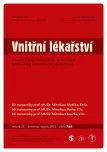Farmacotherapy of hypertension after heart transplantation
Authors:
L. Špinarová; P. Hude; J. Krejčí; H. Poloczková; J. Godava; J. Vítovec
Authors‘ workplace:
I. interní kardioangiologická klinika Lékařské fakulty MU a FN u sv. Anny – ICRC Brno, přednosta prof. MUDr. Jiří Vítovec, CSc., FESC
Published in:
Vnitř Lék 2012; 58(7 a 8): 224-227
Category:
60th Birthday prof. MUDr. Miroslav Souček, CSc.
Overview
Heart transplantation is now used for the treatment of severe heart failure. In a long-term patient follow-up, hypertension has been identified as a complication. Incidence of hypertension in patients treated with cyclosporine and prednisone is between 70–90%. Besides the traditional mechanisms (renin-angiotensin system, fluid volume and peripheral resistance), aetiology of hypertension includes negative effect of cardiac denervation, cyclosporine immunosuppression, administration of corticosteroids and nephropathy. There is no night drop in the blood pressure and heart rate. Treatment aims to maintain cyclosporine level as low as possible and, if feasible, to discontinue steroids during the first year. Hypertension is usually treated with a combination therapy. Our own observations suggest that the majority of post-transplantation patients have a dual therapy. Calcium channel blockers should be the treatment of choice as they also have an effect on graft vasculopathy. Angiotenzin-converting enzyme (ACE) inhibitors or angiotensin II receptor blockers (ARB), beta-blockers and diuretics are also recommended. Long-acting products should be preferred.
Key words:
heart transplantation – hypertension – pharmacotherapy
Sources
1. Hošková L, Podzimková M, Málek I et al. Specifika péče o nemocné po transplantaci srdce. Cor Vasa 2011; 53 : 60–67.
2. Špinarová L. Transplantace srdce. Cor Vasa 2008; 50 : 133–138.
3. Wagoner LE. Management of the cardiac transplant recipient: roles of the transplant cardiologist and primary care physician. Am J Med Sci 1997; 314 : 173–184.
4. Sánchez Lázaro IJ, Bonet LA, Martínez-Dolz L et al. Hypertension after heart transplantation: predictive factors and classes of drugs for its management. Transpl Proc 2008; 40 : 3051–3052.
5. Singer DRJ, Jenkins GH. Hypertension in transplant recipients. J Hum Hypertens 1996; 10 : 395–402.
6. Ventura HO, Mehra MR, Stapleton DD et al. Cyclosporine-induced hypertension in cardiac transplantation. Med Clin North Am 1997; 81 : 1347–1357.
7. Ventura HO, Malik FS, Mehra MR et al. Mechanisms of hypertension in cardiac transplantation and the role of cyclosporine. Curr Opin Cardiol 1997; 12 : 375–381.
8. Lanuza D, Grady K, Hetfleisch M et al. Circadian rhythm changes in blood pressure and heart rate during the first year after heart transplantation. J Heart Lung Transplant 1994; 13 : 614–623.
9. Vítovec J, Špinar J. Vliv ramiprilu na metabolické, renální a srdeční funkce u hypertenze a diabetes mellitus 2. typu. Vnitř Lék 1998; 44 : 336–341.
10. Lucini D, Milani RV, Ventura HO et al. Cyclosporine-induced hypertension: evidence for maintaned baroreflex circulatory control. J Heart Lung Transplant 1997; 16 : 615–620.
11. Braith RW, Mills RM Jr, Wilcox C et al. Breakdown of blood pressure and body fluid homeostasis in heart transplant recipients. J Am Coll Cardiol 1996; 27 : 375–383.
12. Braith RW, Mills RM Jr, Wilcox C et al. Fluid homeostasis after heart transplantation: the role of denervation. J Heart Lung Transplant 1996; 15 : 872–880.
13. European FK 506 Multicentre Study Group. Randomised trial comparing tacrolimus (FK506) to cyclosporine in prevention of liver allograft rejection. Lancet 1994; 344 : 423–428.
14. Mayer A, Dmitrewski J, Squifflet J et al. Multicenter randomised trial comparing tacrolimus (FK 506) and cyclosporine in prevention of renal allograft rejection: a report of the European Tacrolimus Multicenter Renal Study Group. Transplantation 1997; 64 : 436–443.
15. Pirsch JD, Miller J, Deierholi M et al. A comparison of tacrolimus (FK506) and cyclosporine for immunosuppresion after cadaveric renal transplantation: FK506 Kidney Transplant Study Group. Transplant 1997; 63 : 977–983.
16. MacDonald AS. Impact of immunosuppressive therapy on hypertension. Transplantation 2000; 70 (11 Suppl): S70–S76.
17. Špinar J, Souček M. Přehodnocení doporučení pro diagnostiku a léčbu hypertenze. Vnitř Lék 2010; 56 : 157–161.
18. Schroeder JS, Gao SZ, Aldermann EL et al. A preliminary study of diltiazem in the prevention of coronary artery disease in heart-transplant recipients. N Engl J Med 1993; 328 : 164–170.
19. Krejčí J, Hude P, Špinarová L et al. Transplantace srdce – indikace, komplikace, terapie – naše zkušenosti ze sledování 100 pacientů po srdeční transplantaci. Vnitř Lék 2000; 46 : 750–755.
20. Brozena SC, Johnson MR, Ventura HO et al. Effectiveness and safety of diltiazem or lisinopril in treatment of hypertension after heart transplantation. Results of a prospective, randomized multicenter trail. J Am Coll Cardiol 1996; 27 : 1707–1712.
21. Schwitzer GK, Hartmann A, Kober G et al. Chronic angiotensin-converting enzyme inhibition may improve sodium excretion in cardiac transplant hypertension. Transplantation 1995; 59 : 999–1004.
22. Almenar L, Osa A, Palencia M et al. Effects of fosinopril on the blood pressure and lipid profile of patients undergoing heart transplantation. J Heart Lung Transplant 1997; 16 : 454–459.
23. Midtvedt K, Neumayer HH. Management strategies for posttransplant hypertension. Transplantation 2000; 70 (11 Suppl): S64–S69.
Labels
Diabetology Endocrinology Internal medicineArticle was published in
Internal Medicine

2012 Issue 7 a 8
Most read in this issue
- Myocardial infarction the young – our results and experience
- An anaesthesiologist’s perspective on requirements for pre-surgery examinations
- Megakaryopoesis and platelet genesis
- Aldosterone antagonists in chronic heart failure treatment
